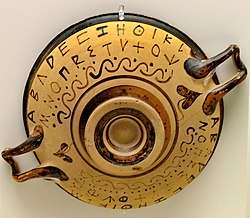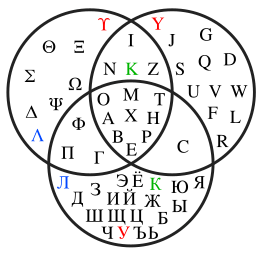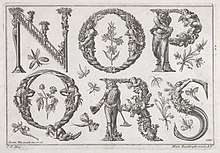Letter (alphabet)
A letter is a segmental symbol of a phonemic writing system. The inventory of all letters forms the alphabet. Letters broadly correspond to phonemes in the spoken form of the language, although there is rarely a consistent, exact correspondence between letters and phonemes.[1]

The word letter, borrowed from Old French letre, entered Middle English around 1200 CE, eventually displacing the native English term bōcstaf (bookstaff). Letter is descended from the Latin littera, which may have descended from the Greek "διφθέρα" (writing tablet), via Etruscan.[2]
Definition and usage
A letter is a type of grapheme, which is a contrastive unit in a writing system. The contemporary English-language alphabet consists of twenty-six letters, each of which corresponds to one or more sounds. Letters are combined to form words. A letter is classified as either a consonant or a vowel, depending on how its sound is produced (vowels are a, e, i, o, u, y and w— with y and w only sometimes classed as vowels). The basic Roman alphabet is used by hundreds of languages around the world.[3]
There are more phonemes in English–about 44–than there are letters of the alphabet.[4] A letter may therefore be associated with more than one phoneme, with the phoneme determined by the surrounding letters or etymology of the word. Regional accents have a significant effect; the letter a can range from five to twelve sounds depending on the origin of the speaker.[5] As an example of positional effects, the letter c is pronounced [k] before a, o, u, or consonants (e.g. critical), but is pronounced [s] before e, i, or y (e.g. democracy). Conversely, the same phoneme may be shared by more than one letter, as shown by the c and s in fence and tense.
A sequence of graphemes representing a phoneme is called a polygraph. A digraph is a case of polygraphy consisting of two graphemes.[6] Examples of digraphs in English include ch, sh, and th. A phoneme can also be represented by three letters, called a trigraph. An example is the combination sch in German.
Specific names are associated with letters, which may differ with language, dialect, and history. Z, for example, is usually called zed in all English-speaking countries except the US, where it is named zee. As elements of alphabets, letters have prescribed orders, although this too may vary by language. In Spanish, for instance, ñ is a separate letter, sorted after n. In English, n and ñ are classified alike.
Letters may also have a numerical or quantitative value. This applies to Roman numerals and the letters of other writing systems. In English, Arabic numerals are typically used instead of letters. Greek and Roman letters are used as mathematical symbols in equations and expressions.
People and objects are sometimes named after letters, for one of these reasons:
- The letter is an abbreviation, e.g. "G-man" as slang for a Federal Bureau of Investigation agent, arose as short for "Government Man"
- Alphabetical order used as a counting system, e.g. Plan A, Plan B, etc.; alpha ray, beta ray, gamma ray, etc.
- The shape of the letter, e.g. A-clamp, A-frame, D-ring, F-clamp, G-clamp, H-block, H engine, O-ring, R-clip, U engine, U-bend, V engine, W engine, X engine, Z-drive, a river delta, omega block
- Other reasons, e.g. X-ray after "x the unknown" in algebra, because the discoverer did not know what they were
Classical definition

The Consistori del Gay Saber was the first literary academy in the world and held the Floral Games to award the best troubadour with the violeta d'aur top prize. Guilhem Molinier, a member of the academy, gave a definition of the letter in his Leys d'Amors (1328–1337), a book aimed at regulating then-flourishing Occitan poetry:
|
Letra votz no es devisabla. E per escriure convenabla. Letra per miels esser exposta. Es menor part de votz composta. |
A letter is an indivisible sound That is fit for writing; A letter, to define it better, Is the smallest part of a composite sound. |
Types of letters
_(14763332785).jpg)
Examples of alphabets and their letters

Worldwide there are many alphabets used at present, with Arabic, Cyrillic, and Latin in widest use. The following alphabets, abjads, and individual letters are discussed in related articles. Each represents a different script:
| Example alphabet | Letters in example alphabet |
|---|---|
| Assamese alphabet | অ, আ, ই, ঈ, উ, ঊ, ঋ, এ, ঐ, ও, ঔ, ক, খ, গ, ঘ, ঙ, চ, ছ, জ, ঝ, ঞ, ট, ঠ, ড, ঢ, ণ, ত, থ, দ, ধ, ন, প, ফ, ব, ভ, ম, য, ৰ, ল, ৱ, শ, ষ, স, হ,ক্ষ, ড়, ঢ়, য়, ৎ, ং, ঃ, ঁ |
| Arabic alphabet | (Alphabetical from right to left) ﺍ, ﺏ, ﺕ, ﺙ, ﺝ, ﺡ, ﺥ, ﺩ, ﺫ, ﺭ, ﺯ, ﺱ, ﺵ, ﺹ, ﺽ, ﻁ, ﻅ, ﻉ, ﻍ, ﻑ, ﻕ, ﻙ, ﻝ, ﻡ, ﻥ, هـ, ﻭ, ﻱ |
| Armenian alphabet | Ա, Բ, Գ, Դ, Ե, Զ, Է, Ը, Թ, Ժ, Ի, Լ, Խ, Ծ, Կ, Հ, Ձ, Ղ, Ճ, Մ, Յ, Ն, Շ, Ո, Չ, Պ, Ջ, Ռ, Ս, Վ, Տ, Ր, Ց, Ւ, Փ, Ք, Օ, Ֆ |
| Syriac alphabet | (Alphabetical from right to left) ܐ, ܒ, ܓ, ܕ, ܗ, ܘ, ܙ, ܚ, ܛ, ܝ, ܟܟ, ܠ, ܡܡ, ܢܢ, ܣ, ܥ, ܦ, ܨ, ܩ, ܪ, ܫ, ܬ |
| Cyrillic script | А, Б, В, Г, Д, Е, Ё, Ж, З, И, Й, К, Л, М, Н, О, П, Р, С, Т, У, Ф, Х, Ц, Ч, Ш, Щ, Ъ, Ы, Ь, Э, Ю, Я |
| Georgian script | ა, ბ, გ, დ, ე, ვ, ზ, თ, ი, კ, ლ, მ, ნ, ო, პ, ჟ, რ, ს, ტ, უ, ფ, ქ, ღ, ყ, შ, ჩ, ც, ძ, წ, ჭ, ხ, ჯ, ჰ |
| Greek alphabet | Α, Β, Γ, Δ, Ε, Ζ, Η, Θ, Ι, Κ, Λ, Μ, Ν, Ξ, Ο, Π, Ρ, Σ, Τ, Υ, Φ, Χ, Ψ, Ω |
| Hebrew alphabet | (Alphabetical from right to left) א, ב, ג, ד, ה, ו, ז, ח, ט, י, כ, ל, מ, נ, ס, ע, פ, צ, ק, ר, ש, ת |
| Latin alphabet | A, B, C, D, E, F, G, H, I, J, K, L, M, N, O, P, Q, R, S, T, U, V, W, X, Y, Z, & |
| Hangul | ㄱ ㄲ ㄴ ㄷ ㄸ ㄹ ㅁ ㅂ ㅃ ㅅ ㅆ ㅇ ㅈ ㅉ ㅊ ㅋ ㅌ ㅍ ㅎ ㅏ ㅐ ㅑ ㅒ ㅓ ㅔ ㅕ ㅖ ㅗ ㅘ ㅙ ㅚ ㅛ ㅜ ㅝ ㅞ ㅟ ㅠ ㅡ ㅢ ㅣ |
| Burmese | က ခ ဂ ဃ င စ ဆ ဇ ဈ ည ဋ ဌ ဍ ဎ ဏ တ ထ ဒ ဓ န ပ ဖ ဗ ဘ မ ယ ရ လ ဝ သ ဟ ဠ အ |
| Bopomofo | ㄅ ㄆ ㄇ ㄈ ㄉ ㄊ ㄋ ㄌ ㄍ ㄎ ㄏ ㄐ ㄑ ㄒ ㄓ ㄔ ㄕ ㄖ ㄗ ㄘ ㄙ ㄚ ㄛ ㄜ ㄝ ㄞ ㄟ ㄠ ㄡ ㄢ ㄣ ㄤ ㄥ ㄦ ㄧ ㄨ ㄩ ㄭ |
| Ogham | ᚁ ᚂ ᚃ ᚄ ᚅ ᚆ ᚇ ᚈ ᚉ ᚊ ᚋ ᚌ ᚍ ᚎ ᚏ ᚐ ᚑ ᚒ ᚓ ᚔ ᚕ ᚖ ᚗ ᚘ ᚙ ᚚ ᚛ ᚜ |
| Ethiopic | ሀ ለ ሐ መ ሠ ረ ሰ ቀ በ ተ ኀ ነ አ ከ ወ ዐ ዘ የ ደ ገ ጠ ጰ ጸ ፀ ፈ ፐ |
| Tifinagh (Amazigh alphabet) | ⴰ, ⴱ, ⵛ, ⴷ, ⴹ, ⴻ, ⴼ, ⴳ, ⴳⵯ, ⵀ, ⵃ, ⵉ, ⵊ, ⴽ, ⴽⵯ, ⵍ, ⵎ, ⵏ, ⵓ, ⵄ, ⵖ, ⵅ, ⵇ, ⵔ, ⵕ, ⵙ, ⵚ, ⵜ, ⵟ, ⵡ, ⵢ, ⵣ, ⵥ |
The International Phonetic Alphabet is used to represent exact pronunciation, for example, [ʔ], which is named a glottal stop.
For other writing systems and their letters, see List of writing systems.
Upper case and lower case
A letter can have multiple variants, or allographs, related to variation in style of handwriting or printing. Some writing systems have two major types of allographs for each letter: an uppercase form (also called capital or majuscule) and a lowercase form (also called minuscule). Upper- and lowercase letters represent the same sound, but serve different functions in writing. Capital letters are most often used at the beginning of a sentence, as the first letter of a proper name or title, or in headers or inscriptions.[7] They may also serve other functions, such as in the German language where all nouns begin with capital letters.
In practical terms, tests have proven that lowercase words are easier to read. They also take up less space on the page, a considerable benefit when materials such as paper and ink were scarce and valuable.
The terms uppercase and lowercase originated in the days of handset type for printing presses. Individual letter blocks were kept in specific compartments of drawers in a type case. Capital letters were stored in a higher drawer or upper case.
Typeface and font
A typeface, or font, is a single, stylistically consistent set of designs for an alphabet. A particular font may alter standard forms of characters, may present them with different optical weight, or may angle or embellish their forms. In calligraphy, letters are artistically handwritten and may or may not be consistent throughout a work.
Typography has traditionally been considered an art form, encompassing both letter design and the relationship of the letters to one another. Type designers strive for clarity and beauty in individual letterforms, as well as character in a font. Old fonts such as Bodoni, Caslon, and Garamond have been in wide use for centuries, with only slight modifications. Advances in print capabilities, new ways of viewing the written word, and changing aesthetics have led to refinements of classic typefaces as well as the introduction of entirely new designs. In the early nineteenth century, sans serif typefaces were first created. Serifs are the finishing strokes of letters, small extensions considered to enhance readability. Sans serif fonts (such as the one you are reading here) give a modern and informal impression, but are slightly less legible as text than serif faces. Without serifs, an uppercase I (I) is indistinguishable from a lowercase l (l).
Letter frequencies
The average distribution of letters, or the relative frequency of each letter's occurrence in text in a given language, can be obtained by analyzing large amounts of representative text. This information can be useful in cryptography and for other purposes, such as song lyrics. Letter frequencies vary in different types of writing.
History of alphabetic writing
Before there were alphabets there were pictographs: small pictures representing objects and concepts. Ancient Egyptian examples date to about 3000 BCE.[8] Pictographs could communicate basic ideas, but were general and ambiguous if they were comprehensible at all. Tense, for example, could not be specified, and symbols do not necessarily carry meaning across cultures. Memorization of tens of thousands of symbols is a daunting task; children from cultures that use logograms–word symbols–to represent words take years longer to learn to read and write than children learning an alphabet. The relative ease of memorizing 26 letters contributed to the spread of literacy throughout the world.
The first consonantal alphabet found emerged around 1800 BCE to represent the language of the Phoenicians, Semitic workers in Egypt (see Middle Bronze Age alphabets), and was derived from the alphabetic principles of the Egyptian hieroglyphs. Our present Roman system derives from this Phoenician alphabet, which had 22 letters. Nineteen of our present letters evolved from the early Phoenician forms; letter shapes and order of appearance correspond closely. The Greek alphabet, adapted around 800 BCE, added four letters. This was the first alphabet assigning letters not only to consonant sounds, but also to vowels.[9] The Roman Empire brought the development and refinement of our Roman alphabet, beginning around 500 BCE. The Romans added or dropped certain letters to accommodate Greek and Etruscan words; they also experimented with styles such as cursive when writing in ink. By about the fifth century CE, the beginnings of lowercase letterforms began to emerge in Roman writing, but they did not come into common use until the end of the Middle Ages, a thousand years later.
More recently, the development of SMS (Short Message Service) technology is eliminating use of unnecessary letters in informal communication. Time pressure and limited character counts have introduced common abbreviations and variations such as gr8fl (grateful) and lite, as well as acronyms like idk (I don't know) and the ubiquitous LOL.
See also
- Abecedarium
- Artificial script
- Character (computing)
- Collation
- Diacritic
- Digraph (orthography)
- Glyph
- Grapheme
- Greek letters used in mathematics
- History of the alphabet
- Letterform
- Ligature
- Orthography
- Roman letters used in mathematics
- Typeface
- Typography
- Unicode
References
- Rogers 2005, p. 13-14.
- Harper, Douglas. "Origin and meaning of letter". Online Etymology Dictionary. Archived from the original on 2017-11-03.
- Rogers 2005, p. 4.
- Sacks 2003, p. 5
- Sacks 2003, p. 49
- Rogers 2005, p. 35.
- Rogers 2005, p. 10-11.
- Healey, J.F. (1990). The Early Alphabet. Reading the past. University of California Press. p. 7. ISBN 978-0-520-07309-8. Retrieved 21 May 2019.
- Millard 1986, p. 396
Sources
- Millard, AR (1986), "The Infancy of the Alphabet", World Archaeology, 17 (3): 390–398, doi:10.1080/00438243.1986.9979978
- Sacks, David (2003). Language Visible: unraveling the mystery of the alphabet from A to Z (First ed.). New York: Broadway Books. ISBN 978-0-7679-1172-6. OCLC 51210302.
- Rogers, Henry (2005). Writing Systems. Blackwell Publishing. ISBN 978-0631234647.CS1 maint: ref=harv (link)
Further reading
- Clodd, Edward (1904). The Story of the Alphabet. [New York]: McClure, Phillips & Co.
- Daniels, Peter T, and William Bright, eds (1996). ISBN 0-19-507993-0.
- Fromkin, Victoria, Robert Rodman, and Nina Hyams (2014). An Introduction to Language (Tenth Ed.). [Boston]: Wadsworth Cengage. ISBN 978-1-1333-1068-6.
- Man, John (2005) [1941]. Alpha beta : how 26 letters shaped the Western world. [New York]: Barnes and Noble. ISBN 978-0-7607-6610-1. OCLC 60936567.
- Powell, Barry B. (1991). Homer and the Origin of the Greek Alphabet. ISBN 978-0-521-58907-9 | ISBN 0-521-58907-X.
- Robinson, A (2003). "The Origins of Writing" in Crowley, David and Paul Heyer Communication in History : Technology, Culture, Society (Fourth Ed). [Boston]: Allyn and Bacon pp 34–40.
External links
| Wikimedia Commons has media related to Letters. |
| Look up letter in Wiktionary, the free dictionary. |



